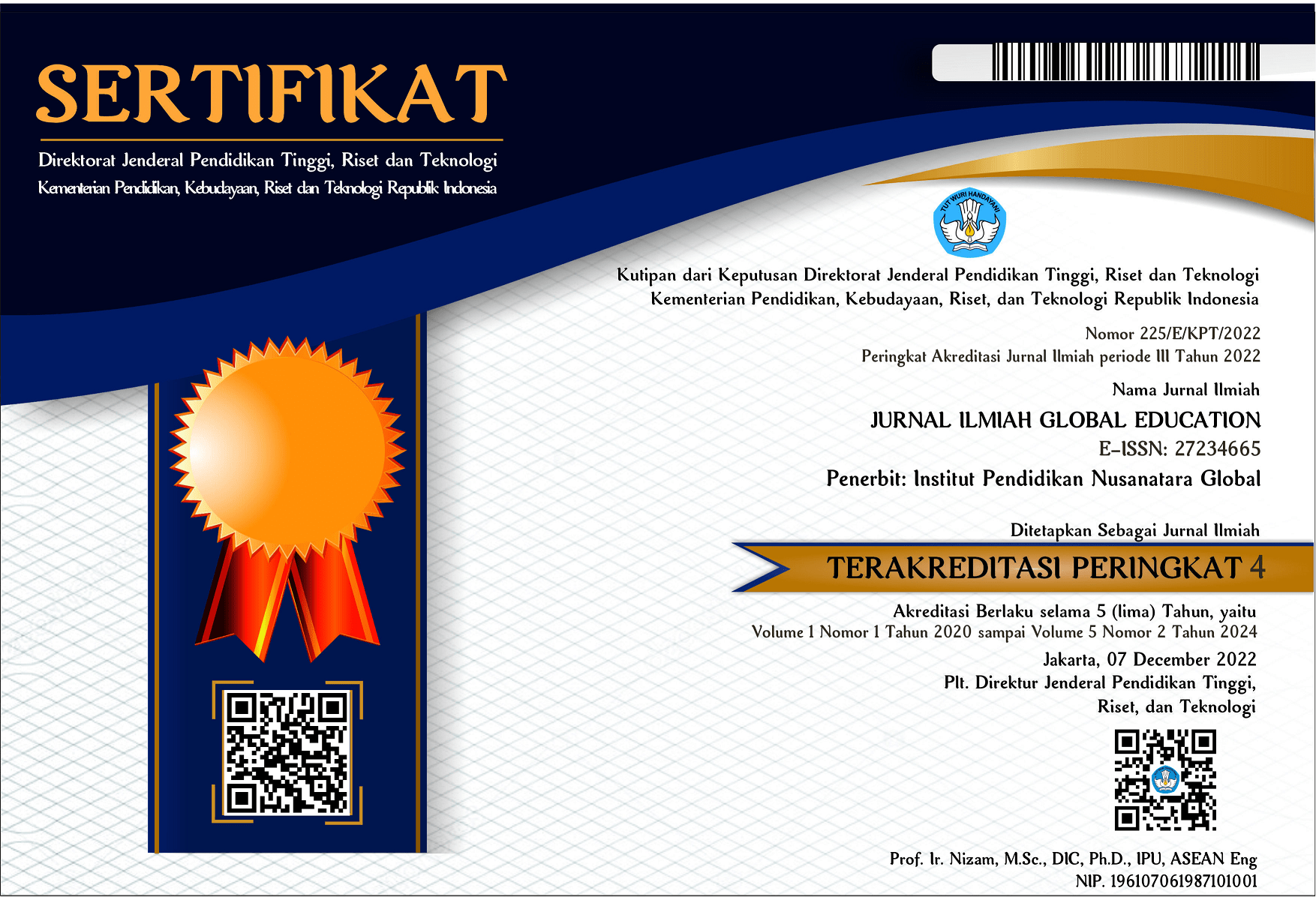PERLUASAN MODEL PENERIMAAN TEKNOLOGI PADA ROBOT BARISTA DI FAMILYMART JAKARTA
DOI:
https://doi.org/10.55681/jige.v4i3.1256Keywords:
E-TAM, Technology, SMART PLSAbstract
The integration of technology in every industry is inevitable, including the food and beverage service. The use of robot barista in Jakarta is a first and worthy of investigating the acceptance intentions of the people who use them. This research aims to analyze the factors that influence consumer attitudes and acceptance intentions towards robot baristas. The model used is E-TAM, an extension of the technology acceptance model. A quantitative explanatory approach with PLS-SEM is employed in this study, using a purposive sampling technique. The research instrument used is an online questionnaire with 160 samples. Data processing using SMART PLS shows relevant results consistent with previous research. Only the perception of innovation does not influence acceptance intentions due to cultural background differences among the population. Future research should attempt to use samples with other demographic characteristics and include other exogenous variables.
Downloads
References
Alalwan, A. A., Baabdullah, A. M., Rana, N. P., Tamilmani, K., & Dwivedi, Y. K. (2018). Examining adoption of mobile internet in Saudi Arabia: Extending TAM with perceived enjoyment, innovativeness and trust. Technology in Society, 55, 100-110. https://doi.org/10.1016/j.techsoc.2018.06.007
Albayrak, A (2014) Müşterilerin Restoran Seçimlerini Etkileyen &aktörler: Istanbul Örneği Anatolia: Turizm Araştırmaları Dergisi, 25(2), 190. https://doi.org/10.17123/atad.vol25iss255949
Alsabawy, A. Y., Cater-Steel, A., & Soar, J. (2016). Determinants of perceived usefulness of e-learning systems. Computers in Human Behavior, 64, 843-858. https://doi.org/10.1016/j.chb.2016.07.065
Aytasova, A., Selezneva, Z., Belinskaia, I., & Evdokimov, K. (2019). Development of the process map “research and development” for agricultural organizations IOP Conference Series: Materials Science and Engineering, 666(1). https://doi.org/10.1088/1757-899X/666/1/012072
Bae, J.-H., & Jeon, H.-M. (2022). Exploring the relationships among brand experience, perceived product quality, hedonic value, utilitarian value, and brand loyalty in unmanned coffee shops during the covid-19 pandemic. Sustainability, 14(18), 11713. https://doi.org/10.3390/su141811713
Cavusoglu, M. (2019). An analysis of technology applications in the restaurant industry. Journal of Hospitality and Tourism Technology, 10(1), 45-72. https://doi.org/10.1108/JHTT-12-2017-0141
Charness, N., & Boot, W. R. (2015). Technology, Gaming, and Social Networking. In Handbook of the Psychology of Aging: Eighth Edition. Elsevier Inc. https://doi.org/10.1016/B978-0-12-411469-2.00020-0
Choi, E. J., & Kang, S. W. (2018). The Relationship between Acceptance Intention Toward a Smartphone Healthcare Application and Health-Promoting Behaviors among Nursing Students. CIN - Computers Informatics Nursing, 36(10), 494-500. https://doi.org/10.1097/CIN.0000000000000433
Collier, J. E., & Kimes, S. E. (2012). Only If It Is Convenient: Understanding How Convenience Influences Self-Service Technology Evaluation. Journal of Service Research, 16(1), 39-51. https://doi.org/10.1177/1094670512458454
Davis, F. D., Bagozzi, R. P., & Warshaw, P. R. (1989). User Acceptance of Computer Technology: A Comparison of Two Theoretical Models. Management Science, 35(8), 982-1003. https://doi.org/10.1287/mnsc.35.8.982
Diop, E. B., Zhao, S., & Duy, T. Van. (2019). An extension of the technology acceptance model for understanding travelers’ adoption of variable message signs PLoS ONE, 14(4), 1-17. https://doi.org/10.1371/journal.pone.0216007
Doorn, J. van, Mende, M., Noble, S. M., Hulland, J., Ostrom, A. L., Grewal, D., & Petersen, J. A. (2016). Domo Arigato Mr. Roboto: Emergence of Automated Social Presence in Organizational &rontlines and Customers’ Service Experiences. Journal of Service Research. https://doi.org/10.1177/1094670516679272
Eastlick, M. A., Ratto, C., Lotz, S. L., & Mishra, A. (2012). Exploring antecedents of attitude toward co-producing a retail checkout service utilizing a self-service technology. International Review of Retail, Distribution and Consumer Research, 22(4), 337–364. https://doi.org/10.1080/09593969.2012.690775
El-Said, O., & Al Hajri, S. (2022). Are customers happy with Robot Service? investigating satisfaction with robot service restaurants during the COVID-19 pandemic. Heliyon, 8(3). https://doi.org/10.1016/j.heliyon.2022.e08986
Falkner, L. (2020). An Exploratory Study of Generational Coffee Preferences. Murray State’s Digital Commons, 24–28.
Gibson, L. A., & Sodeman, W. A. (2014). Millennials and Technology: Addressing the Communication Gap in Education and Practice. Organization Development Journal. 32(4), 63–75.
Hair, J. F., Black, W. C., Babin, B. J., & Anderson, R. E. (2019). Multivariate Data Analysis. Cengage Learning, EMEA.
Hanafizadeh, P., Behboudi, M., Abedini Koshksaray, A., & Jalilvand Shirkhani Tabar, M. (2012). Mobile-banking adoption by Iranian bank clients. Telematics and Informatics, 31(1), 62–78. https://doi.org/10.1016/j.tele.2012.11.001
Henseler, J., Dijkstra, T. K., Sarstedt, M., Ringle, C. M., Diamantopoulos, A., Straub, D. W., Ketchen, D. J., Hair, J. F., Hult, G. T., & Calantone, R. J. (2014). Common beliefs and reality about PLS. Organizational Research Methods, 17(2), 182–209. https://doi.org/10.1177/1094428114526928
Holdack, E., Lurie-Stoyanov, K., & Fromme, H. F. (2020). The role of perceived enjoyment and perceived informativeness in assessing the acceptance of AR Wearables. Journal of Retailing and Consumer Services, 65, 102259. https://doi.org/10.1016/j.jretconser.2020.102259
Hussein, Z. (2017). Leading to intention: The role of attitude in relation to technology acceptance model in e-learning. Procedia Computer Science, 105, 159–164. https://doi.org/10.1016/j.procs.2017.01.196
Hwang, J., Choe, J. Y. (Jacey), Kim, H. M., & Kim, J. J. (2021). Human baristas and robot baristas: How does brand experience affect brand satisfaction, brand attitude, brand attachment, and brand loyalty? International Journal of Hospitality Management, 103050. https://doi.org/10.1016/j.ijhm.2021.103050
Hwang, J., Kim, H., Kim, J. J., & Kim, I. (2021). Investigation of perceived risks and their outcome variables in the context of robotic restaurants. Journal of Travel and Tourism Marketing, 38(3), 263–281. https://doi.org/10.1080/10548408.2021.1906826
Hwang, J., Lee, J. S., & Kim, H. (2019). Perceived innovativeness of drone food delivery services and its impacts on attitude and behavioral intentions: The moderating role of gender and age. International Journal of Hospitality Management, 81(3), 94–103. https://doi.org/10.1016/j.ijhm.2019.03.002
Jin, N. (Paul), Goh, B., Huffman, L., & Yuan, J. J. (2014). Predictors and outcomes of perceived image of restaurant innovativeness in fine-dining restaurants. Journal of Hospitality Marketing & Management, 24(5), 457–485. https://doi.org/10.1080/19368623.2014.915781
Joiner, I. A. (2018). Robotics. Emerging Library Technologies, 23–44. https://doi.org/10.1016/b978-0-08-102253-5.00001-0
Kabir, M. A., Saidin, S. Z., & Ahmi, A. (2017). The influence of perceived usefulness and perceived ease of use on the continuous intention to use electronic collection system in Nigerian hospitals: a conceptual approach. Asian Journal of Multidisciplinary Studies, 5, 225-228.
Kaushik, A. K., & Rahman, Z. (2015a). Are street vendors really innovative toward self-service technology? Information Technology for Development, 22(2), 334–356. https://doi.org/10.1080/02681102.2015.1052359
Kaushik, A. K., Agrawal, A. K., & Rahman, Z. (2015b). Tourist behaviour towards self-service hotel technology adoption: Trust and subjective norm as key antecedents. Tourism Management Perspectives, 16, 278–289. https://doi.org/10.1016/j.tmp.2015.09.002
Kesharwani, A., & Singh Bisht, S. (2012). The impact of trust and perceived risk on internet banking adoption in India. International Journal of Bank Marketing, 30(4), 303–322. https://doi.org/10.1108/02652321211236923
Khazaei, A., Manjiri, H., Samiey, E., & Najafi, H. (2014). The Effect of Service Convenience on Customer Satisfaction and Behavioral Intention in Bank Industry. International Journal of Sciences: Basic and Applied Research, 3(1), 16-23. https://doi.org/10.47584/jfm.2021.24.4.73
Kim, G., & Park, S. A. (2022). Understanding restaurant users’ attitudes towards self-service ordering via kiosks during the COVID-19 pandemic: An application of the theory of anxiety. Tourism and Hospitality Research, 146735842211336. https://doi.org/10.1177/14673584221133666
Kim, H. M., & Ryu, K. (2021). Examining image congruence and its consequences in the context of robotic coffee shops. Sustainability, 13(20), 11413. https://doi.org/10.3390/su132011413
Kim, T., Kim, M. C., Moon, G., & Chang, K. (2014). Technology-based self-service and its impact on customer productivity. Services Marketing Quarterly, 35(3), 255–269. https://doi.org/10.1080/15332969.2014.916145
Kim, Y. H., Kim, D. J., & Wachter, K. (2013). A study of mobile user engagement (Moen): Engagement motivations, perceived value, satisfaction, and continued engagement intention. Decision Support Systems, 56, 361–370. https://doi.org/10.1016/j.dss.2013.07.002
Kock, N., & Hadaya, P. (2016). Minimum sample size estimation in PLS-sem: The inverse square root and gamma-exponential methods. Information Systems Journal, 28(1), 227–261. https://doi.org/10.1111/isj.12131
KOMPAS.com. (2022). FamilyMart Peritel Modern Pertama di Indonesia yang Mengoperasikan Robot Barista. Retrieved from https://foto.kompas.com/photo/read/2022/1/8/1641622747b1c/1/familymartperitel-modern-pertama-di-indonesia-yang-mengoperasikan-robot-barista
Lee, W. H., Lin, C. W., & Shih, K. H. (2018). A technology acceptance model for the perception of Restaurant Service Robots for trust, interactivity, and output quality. International Journal of Mobile Communications, 16(4), 361. https://doi.org/10.1504/ijmc.2018.092666
Lowe, B., & Alpert, F. (2015). Forecasting consumer perception of Innovativeness. Technovation, 45-46, 1–14. https://doi.org/10.1016/j.technovation.2015.02.001
Ma, Z., Gill, T., & Jiang, Y. (2015). Core Versus Peripheral Innovations: The Effect of Innovation Locus on Consumer Adoption of New Products. Journal of Marketing Research, 52(3), 309–324. http://www.jstor.org/stable/43832361
Matute-Vallejo, J., & Melero-Polo, I. (2019). Understanding Online Business Simulation Games: The role of flow experience, perceived enjoyment and personal innovativeness. Australasian Journal of Educational Technology, 35(3). https://doi.org/10.14742/ajet.3862
Moon, J., Shim, J., & Lee, W. S. (2022). Antecedents and consequences of the ease of use and usefulness of fast food kiosks using the technology acceptance model. Systems, 10(5), 129. https://doi.org/10.3390/systems10050129
Regan, M. A., Horberry, T. J., & Stevens, A. (2017). Driver acceptance of new technology: Theory, measurement and optimisation. CRC Press, Taylor & Francis Group.
Renn, O., & Benighaus, C. (2013). Perception of technological risk: Insights from research and lessons for Risk Communication and Management. Journal of Risk Research, 16(3-4), 293–313. https://doi.org/10.1080/13669877.2012.729522
San-Martín, S., López-Catalán, B., & Ramón-Jerónimo, M. A. (2013). Mobile shoppers: Types, drivers, and impediments. Journal of Organizational Computing and Electronic Commerce, 23(4), 350–371. https://doi.org/10.1080/10919392.2013.837793
Sarstedt, M., & Cheah, J. H. (2019). Partial least squares structural equation modeling using SmartPLS: a software review. Journal of Marketing Analytics, 7(3), 196–202. https://doi.org/10.1057/s41270-019-00058-3
Seebode, D., Jeanrenaud, S., & Bessant, J. (2012). Managing innovation for Sustainability. R&D Management, 42(3), 195–206. https://doi.org/10.1111/j.1467-9310.2012.00678.x
Shawky, I., El Enen, M. A., & Fouad, A. (2019). Examining Customers’ Intention and Attitude Towards Reading Restaurants’ Menu Labels by Using the Theory of Planned Behaviour. International Tourism and Hospitality Journal, 2(4), 1–14.
Shereen, M. A., Khan, S., Kazmi, A., Bashir, N., & Siddique, R. (2020). Covid-19 infection: Emergence, transmission, and characteristics of human coronaviruses. Journal of Advanced Research, 24, 91–98. https://doi.org/10.1016/j.jare.2020.03.005
Slade, E. L., Dwivedi, Y. K., Piercy, N. C., & Williams, M. D. (2015). Modeling consumers’ adoption intentions of remote mobile payments in the United Kingdom: Extending utaut with Innovativeness, risk, and Trust. Psychology & Marketing, 32(8), 860–873. https://doi.org/10.1002/mar.20823
Smith, T. A. (2020). The role of customer personality in satisfaction, attitude-to-brand and loyalty in Mobile Services. Spanish Journal of Marketing - ESIC, 24(2), 155–175. https://doi.org/10.1108/sjme-06-2019-0036
Sung, H. J., & Jeon, H. M. (2020). UNTACT: Customer’s acceptance intention toward Robot Barista in coffee shop. Sustainability, 12(20), 8598. https://doi.org/10.3390/su12208598
Tabassum, A., & Rahman, T. (2012). Differences in Consumer Attitude towards Selective Fast Food Restaurants in Bangladesh: An Implication of Multiattribute Attitude Model.
Tella, A., & Olasina, G. (2014). Predicting users' continuance intention toward E-payment system. International Journal of Information Systems and Social Change, 5(1), 47–67. https://doi.org/10.4018/ijissc.2014010104
Thomas, G. (2023). Demystifying the relationship between restaurant innovativeness, customer engagement, and customer willingness to pay a higher price. Sustainability, 15(10), 7795. https://doi.org/10.3390/su15107795
Tsai, Y.-R. (2014). Applying the technology acceptance model (TAM) to explore the effects of A course management system (cms)-assisted EFL writing instruction. CALICO Journal, 32(1), 153–171. https://doi.org/10.1558/calico.v32i1.25961
Valdehita, R. E., Plata, R. B., & Medina-Merodio, J.-A. (2019). Student acceptance of Virtual Laboratory and practical work: An extension of the Technology Acceptance Model. Computers & Education, 135, 1–14. https://doi.org/10.1016/j.compedu.2019.02.010
Vo-Thanh, T., Zaman, M., Thai, T. D.-H., Hasan, R., & Senbeto, D. L. (2022). Perceived customer journey innovativeness and customer satisfaction: A mixed-method approach. Annals of Operations Research. https://doi.org/10.1007/s10479-022-05079-3
Wirtz, J., Patterson, P. G., Kunz, W. H., Gruber, T., Lu, V. N., Paluch, S., & Martins, A. (2018). Brave new world: Service robots in the frontline. Journal of Service Management, 29(5), 907–931. https://doi.org/10.1108/josm-04-2018-0119
Wu, W., Wu, Y. J., & Wang, H. (2021). Perceived city smartness level and technical information transparency: The acceptance intention of health information technology during a lockdown. Computers in Human Behavior, 122, 106840. https://doi.org/10.1016/j.chb.2021.106840
Yilmaz, G., & Gültekin, S. (2016). Consumers and Tourists’ Restaurant Selections. Global Issues and Trends in Tourism, 217–230.
Yoo, S.-R., Kim, S.-H., & Jeon, H.-M. (2022). How does experiential value toward robot barista service affect emotions, storytelling, and behavioral intention in the context of covid-19? Sustainability, 14(1), 450. https://doi.org/10.3390/su14010450
Yulius, Kevin G, Millenia, A. S., Sutarna, D. V., & Joselino, T. Y. (2022). Pengaruh Persepsi konsumen atas Makanan Kaki lima sate Taichan Terhadap Minat Mengunjungi Kembali di Kawasan Senayan, Jakarta Selatan. Jurnal Bangun Manajemen, 1(1), 13–21. https://doi.org/10.56854/jbm.v1i1.12
Downloads
Published
How to Cite
Issue
Section
License
Copyright (c) 2023 JURNAL ILMIAH GLOBAL EDUCATION

This work is licensed under a Creative Commons Attribution-ShareAlike 4.0 International License.













